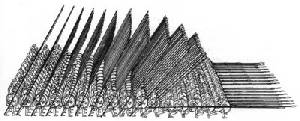
The sarissa or sarisa was a 4 to 7 meter (13–21 feet) long spear used in the ancient Greek and Hellenistic warfare.
It was introduced by Philip II of Macedon and was used in the traditional phalanxes of Philip II of Macedon as a replacement for the earlier dory, which was considerably shorter. The phalanxes of Philip II of Macedon were known as Macedonian phalanxes.
The sarissa, made of tough and resilient cornel wood, was very heavy for a spear, weighing approximately 12 pounds (5.4 kg) for a 15-foot (4.6 m) sarissa and approximately 14.5 pounds (6.6 kg) for an 18-foot (5.5 m) sarissa. It had a sharp iron head shaped like a leaf and a bronze butt-spike that would allow it to be anchored to the ground to stop charges by enemy soldiers. The butt-spike served to balance out the spear, making it easier for soldiers to wield. The butt-spike could be used as a back-up point should the main one break.
The sheer bulk and size of the spear required the soldiers to wield the spear with both hands, allowing them to carry only a 24 inch shield (pelta) suspended from the neck to cover the left shoulder. Its great length — up to eighteen feet in two lengths joined by a central bronze tube — was an asset against hoplites and other soldiers bearing shorter weapons, because they had to get past the sarissas to engage the phalangites. However, outside the tight formation of the Phalanx the sarissa was useless as a weapon and a hindrance on the march.